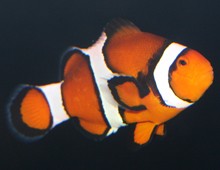Description: True percula clownfish have an orange body with three vertical white lines outlined in black. The first line is just behind the eyes, the second through the middle of the body and the third near the caudal fin. Each fin of the Percula clownfish is outlined in black to different degrees. These clownfish are often confused with Amphiprion ocellaris (false clown anemonefish). In order to distinguish them, one must look at the dorsal-fin spines – A. percula has ten and A. ocellaris has eleven. Also A. ocellaris fins do not have the thick black outlining.
Size: They grow to about 4.3 inches (11 cm) in length, with females being larger than males.
Behavior: They have an interesting swimming style that is different from most fish – they swim by rowing their pectoral fins instead of flapping them. True percula clownfish have a symbiotic relationship with various anemones. The clownfish has a safe haven from predators and the anemone gains food, oxygenation and the removal of waste material. Each social group is a size-based hierarchy: the largest fish is the female, the breeding male is the second largest and the non- breeders get smaller as the hierarchy descends. Males will be aggressive toward the next male of smaller successive size until he chases him away from their host anemone, therefore securing his position in line.
Diet: They feed mainly on zooplankton and small crustaceans.
Communication: Males and females perform spawning rituals such as head standing, touching their ventral surfaces or leaning towards one another with their dorsal surfaces touching.
Reproduction: This fish spawns year-round. Mating takes place within their social group that consists of the breeding pair and zero to four non-breeders. Shortly before spawning occurs the male prepares the nest which is usually located on a patch of rock under the host anemones’s tentacles. Spawning takes place with the female passing over the nest several times releasing her eggs each time as she goes. The male follows closely, fertilizing the eggs externally. The number of eggs the female releases can vary from 100 to over 1,000. Incubation lasts about six to seven days after which the hatched larva will initially sink to the benthic environment but then quickly swim to the surface using a process called phototaxis (using light to orient themself). About 8-12 days after hatching, the juvenile anemonefish will settle to the bottom and look for a host anemone. All of the fish develop into males first and then later they can reverse sex to become female (protandrous hermaphroditism). This occurs in groups when the female dies or leaves the host anenome. The largest male becomes the breeding female, while the largest non-breeder becomes the breeding male.
Habitat/range: Found in coral reefs living within their host anemones throughout the Indo-Pacific region to Australia in the south and southeast Asia in the north.
Status: Not assessed for the IUCN Red List.



